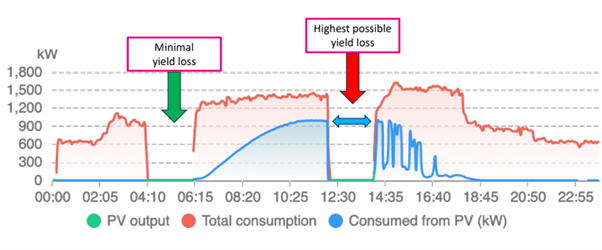Facing load shedding, South African businesses are turning to alternate and renewable energy solutions like grid-tied solar PV systems to reduce their carbon footprint and gain independence from the grid and pursue security of supply. Load shedding presents unique challenges to businesses already equipped with grid-tied only solar PV systems. This article briefly explores the intricate dynamics of how load shedding affects such grid-tied only solar PV systems.
Grid-tied solar PV systems are the most prevalent, simple, and cost-effective solution compared to off-grid and/or hybrid solar PV systems because they can operate without reliance on energy storage equipment. Grid-tied solar PV systems are simpler to install, realise attractive energy cost savings and are thus the most accessible option readily deployable for businesses.
A grid-tied Solar PV system is reliant on the grid’s availability to fully and properly serve the demands of a customer’s facility, meaning that when the grid-tied Solar PV system is not producing enough power to serve the attached load, supplemental power is then drawn from the grid to meet the total site electrical demand. Unfortunately, when the power fails from the utility’s side, the grid-tied Solar PV inverters will switch off for two reasons:
- A grid-tied Solar PV inverter, which is a current-source device will have no reference voltage or grid to inject its power into, the solar PV inverters thus cannot operate. (A hybrid grid-forming Solar PV inverter by comparison is a voltage-source device and does not require to see or detect a grid to operate and will form its own grid without regard to the conditions of the attached equipment and any reliance on a grid interface).
- Safety – if the utility is working on the upstream grid for repairs or maintenance, it cannot have connected energy sources from external systems touching the grid.
These technical requirements and capabilities impact businesses equipped with grid-tied only systems during loadshedding.
Many commercial and industrial (“C&I”) solar PV systems in South Africa are grid-tied. Converting these grid-tied solar PV systems to a hybrid solution is often technically and commercially challenging and requires full and careful consideration for the appropriate scoping of equipment sizing and capacity, along with a full and careful consideration for the type of electrical load at the business premises or facility.
South Africa experiences on average 4.0 to 6.3 hours of peak sunlight per day where PV modules generate the bulk of their output. The figure below shows a grid-tied solar PV system harnessing solar energy during daylight hours when the sun is shining and captures two instances of load shedding.

The impact of loadshedding and the consequential losses is most severe when load shedding takes place during peak solar generation hours.
The impact of load-shedding on these operations has in the past year (2023) shown an average overall impact and loss in energy production of about 20% and Eskom is unlikely to improve the situation in the short-term without a serious and continued intervention and integration of renewable and other energy generation sources into the national grid. Whilst the magnitude of loadshedding is well known, the unpredictable nature of load-shedding and the times in which it occurs makes accurate financial modelling and optimisation of battery solutions difficult and its related financed solutions challenging. Businesses are thus earnestly pursuing conversions to diesel generator integrated and/or battery storage solutions to still be able to harness the solar energy, realise the commercial benefit of the installation, and mitigate against these impacts.
In summary, loadshedding leads to a loss in productivity for grid-tied only solar PV installations and thereby compromised project financial returns. This means that backup sources of power like standby emergency diesel generators need to be purchased, increasing the consumption of fossil fuels, increasing the business’s exposure to volatile fuels costs, and contributing to environmental pollution. Investing in energy storage solutions like batteries to store surplus solar energy and provide backup power during grid outages is increasingly being considered as these storage costs also continue to decrease.
In conclusion, many businesses that have invested in grid-tied solar PV systems, had chosen a sustainable and cost-effective energy solution, realise energy cost reduction, and supplement their fossil fuel energy consumption with green energy. As early adopters of green and alternate energy they have realised the benefits of having made this move. However, during periods of load shedding, reliant on an always available grid, these businesses now find themselves at times incapacitated by the failing grid, disrupting operations and thus being compelled to augment their existing installations with energy storage and generator solutions at a greater expense and investment than originally planned.

